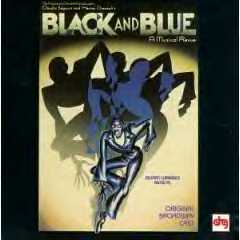
Like their previous Tango Argentino, Claudio Segovia and Hector Orezzoli’s musical dance pastiche Black and Blue hits the Broadway boards after completing a hugely successful run in Paris. The French have long been fascinated by the American jazz and blues idioms, treating it with more reverence than Americans do. But one needs no nationality to appreciate the artistry of the show’s three leading ladies or of its talented corps of hoofers.
Linda Hopkins, Ruth Brown, and Carrie Smith open Black and Blue with a strong, sonorous rendition of “I’m a Woman” that wipes out any memories of Madison Avenue’s white-bread “Enjoli Perfume” commercials of a few years ago. The trio doesn’t share the stage again until their respectable version of the title song closes the show. In between, each has moments, although the comic numbers are the ones that bring down the house. Ms. Brown’s bawdy “If I can’t Sell It, I’ll Keep Sittin’ on It (I ain’t Gonna Give it Away)” hits pure gold with a perfect combination of inflection, timing, and attitude. Her raunchy duet with Linda Hopkins on “T`ain’t Nobody’s Bizniss if I Do” almost over-sells its schtick of comedic one-upmanship, but the duo bash it out like troopers. Carrie Smith’s smoky vocals are less effective. She comes off as a sort of low-key Odetta without the high notes and galvanizing power of that great folksinger. In fact, none of the three headliners has quite the voice to put an indelible stamp on “Am I Blue,” “Body and Soul” and other overly roasted chestnuts.
Much of the dancing, though, is excellent. Complementing Duke Ellington’s “In a Sentimental Mood,” old-timer Bunny Briggs moves with a calm elegance that is as soothing as his sad brown eyes. Jimmy Slyde is true to his name, and the entire troupe are a joy to watch in Frankie Manning’s choreography to Ellington’s “Black and Tan Fantasy.”
Special mention must be made of the younger generation. Dormeshia Shubry and Cyd Glover remind us that before the racial implications sank in, watching Shirley Temple dance up and down a staircase with Bill Robinson was fun. Cyd’s brother Savion, formerly Broadway’s “Tap Dance Kid,” nearly steals the show with his charisma and delight in performing.
So much of the dancing is fine, it pains me to say that Black and Blue would be better with less of it. One sympathizes with creators Claudio Segovia and Hector Orezzoli’s wish to showcase this wealth of immense talent, but too much of a good thing is still too much. It’s hard to pick out individual flaws. I could have lived without Lon Chaney (no relation) and Ralph Brown’s dance skit involving two anging hoofers who are too tired to finish a routine, and perhaps there’s one too many ensemble pieces. Happily, I don’t have to make these decisions, but I do know that at two-and-a-half hours, Black and Blue is 30 minutes too long.
The costumes are usually wonderful, ranging from the longest gown I’ve ever seen to the gorgeous pastels in the “Black and Tan Fantasy” ballet. Sometimes the sets intrude but not fatally, the exception being a changing booth that moves across, around, then off the stage for absolutely no reason. The backing musicians, many of whom have resumes as long as those of the dancers, do a fine job of accompanying without overshadowing the stage performers. Despite occasional ragged patches, the orchestra is mostly solid and the clarinets are sweet as honey.
The best one can get from a show such as this is a feeling of awed admiration for the performers and perhaps a wistful yearning for those dance lessons you could have taken in fifth grade. Black and Blue comes through on both counts, and if I weren’t so tapped out by the production’s length, I might have tapped out of the theater and all the way down Eighth Avenue.
